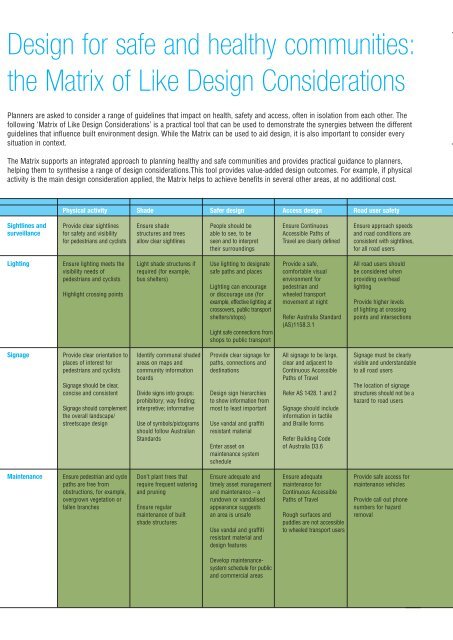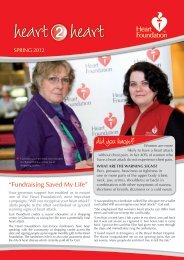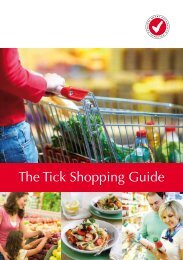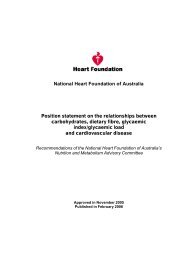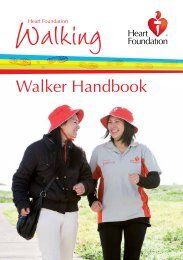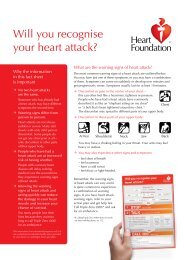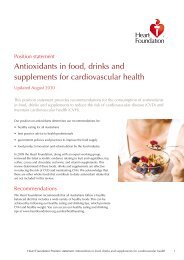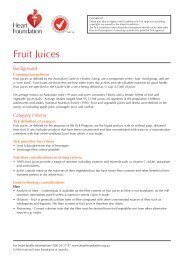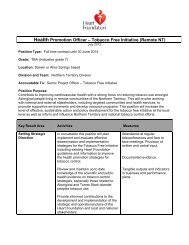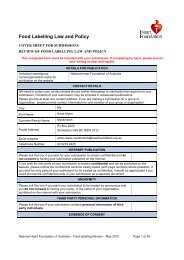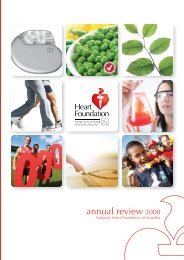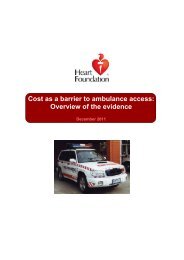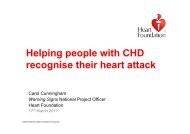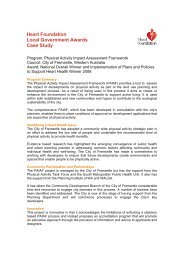Healthy by Design - National Heart Foundation
Healthy by Design - National Heart Foundation
Healthy by Design - National Heart Foundation
You also want an ePaper? Increase the reach of your titles
YUMPU automatically turns print PDFs into web optimized ePapers that Google loves.
<strong>Design</strong> for safe and healthy communities:<br />
the Matrix of Like <strong>Design</strong> Considerations<br />
Planners are asked to consider a range of guidelines that impact on health, safety and access, often in isolation from each other. The<br />
following ‘Matrix of Like <strong>Design</strong> Considerations’ is a practical tool that can be used to demonstrate the synergies between the different<br />
guidelines that influence built environment design. While the Matrix can be used to aid design, it is also important to consider every<br />
situation in context.<br />
The Matrix supports an integrated approach to planning healthy and safe communities and provides practical guidance to planners,<br />
helping them to synthesise a range of design considerations.This tool provides value-added design outcomes. For example, if physical<br />
activity is the main design consideration applied, the Matrix helps to achieve benefits in several other areas, at no additional cost.<br />
Physical activity Shade Safer design Access design Road user safety<br />
Sightlines and Provide clear sightlines Ensure shade People should be Ensure Continuous Ensure approach speeds<br />
surveillance for safety and visibility structures and trees able to see, to be Accessible Paths of and road conditions are<br />
for pedestrians and cyclists allow clear sightlines seen and to interpret Travel are clearly defined consistent with sightlines,<br />
their surroundings<br />
for all road users<br />
Lighting Ensure lighting meets the Light shade structures if Use lighting to designate Provide a safe, All road users should<br />
visibility needs of required (for example, safe paths and places comfortable visual be considered when<br />
pedestrians and cyclists bus shelters) environment for providing overhead<br />
Lighting can encourage pedestrian and lighting<br />
Highlight crossing points or discourage use (for wheeled transport<br />
example, effective lighting at movement at night Provide higher levels<br />
crossovers, public transport<br />
of lighting at crossing<br />
shelters/stops) Refer Australia Standard points and intersections<br />
(AS)1158.3.1<br />
Light safe connections from<br />
shops to public transport<br />
Signage Provide clear orientation to Identify communal shaded Provide clear signage for All signage to be large, Signage must be clearly<br />
places of interest for areas on maps and paths, connections and clear and adjacent to visible and understandable<br />
pedestrians and cyclists community information destinations Continuous Accessible to all road users<br />
boards<br />
Paths of Travel<br />
Signage should be clear,<br />
The location of signage<br />
concise and consistent Divide signs into groups: <strong>Design</strong> sign hierarchies Refer AS 1428. 1 and 2 structures should not be a<br />
prohibitory; way finding; to show information from hazard to road users<br />
Signage should complement interpretive; informative most to least important Signage should include<br />
the overall landscape/<br />
information in tactile<br />
streetscape design Use of symbols/pictograms Use vandal and graffiti and Braille forms<br />
should follow Australian resistant material<br />
Standards<br />
Refer Building Code<br />
Enter asset on of Australia D3.6<br />
maintenance system<br />
schedule<br />
Maintenance Ensure pedestrian and cycle Don’t plant trees that Ensure adequate and Ensure adequate Provide safe access for<br />
paths are free from require frequent watering timely asset management maintenance for maintenance vehicles<br />
obstructions, for example, and pruning and maintenance – a Continuous Accessible<br />
overgrown vegetation or rundown or vandalised Paths of Travel Provide call out phone<br />
fallen branches Ensure regular appearance suggests numbers for hazard<br />
maintenance of built an area is unsafe Rough surfaces and removal<br />
shade structures<br />
puddles are not accessible<br />
Use vandal and graffiti to wheeled transport users<br />
resistant material and<br />
design features<br />
Develop maintenancesystem<br />
schedule for public<br />
and commercial areas


